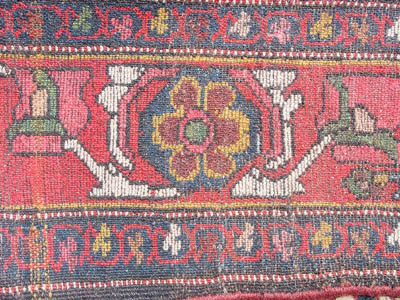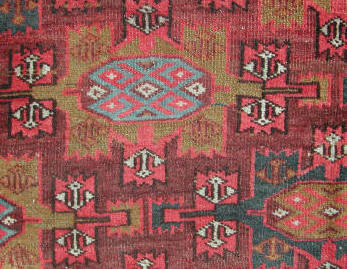Posted by Patrick Weiler on 06-14-2005 10:58 PM:
How about Pink?
It is true that the radioactive synthetic orange colors found in many
Caucasian and south Persian rugs are a factor in the value and desirability of
those rugs, but how about pink? I believe Turkmen rug collectors get very
suspicious of pink. I have a Baluch balisht that has some pink in it and it was
considered to be a synthetic color by a leading dealer, but it has some
tip-fading.
Here is a Kurdish Mina Khani rug with a plethora of pink. There
are several intensities of pink in this rug, from pale to pronounced. None of
them has tip-fading that might be a clue to a synthetic dye.

Here are photos of the front and back
of one of the border elements:

In the lower left of this photo you can see where the weaver
used yellow wefts for a bit and it is easy to see the extra wefts inserted
several inches into the rug to straighten the weaving:

And you can readily see offset
knotting in the white area of this close-up:

There are at least 15 distinct colors
in this rug. The design has become quite disjointed from the original, with the
formerly circular lattice becoming a jerky, stumbling maze and the once tilted
palmettes (the brown"ragged" flowers in the middle of the rug alternating with
the red asters) now facing us straight-on. The "cloudbands" curling from the
pink flowers have separated from some of their flowers and are now floating like
lost botehs in the camel-brown field.
Here is a link to the proper mina
khani design on the Old Carpet web site:
http://www.oldcarpet.com/images/varamin_196_292_mina_khani_500.jpg
Does
anyone else have weavings with garish pinks? Are they real or are they
synthetic?
Patrick Weiler
Posted by Filiberto Boncompagni on 06-15-2005 05:51 AM:
Hi Pat,
I think all the colors of your (nice!) Kurdish rug are
natural.
I have a Jaff Kurd bag with a “hot” pink that is impossible to
render:

Actually the red background of the diamond is more bluish, and
the pink is less bluish, almost a light red. But if I try to correct the
first, the latter changes too much. What you see here is a
compromise.
The photo is taken in direct sunlight that shines back into
the camera, producing overexposed white spots, especially in the pink area. The
brown of the field is heavily corroded. I think all the colors are natural. No
tip fading.
Regards,
Filiberto
Posted by Richard Tomlinson on 06-15-2005 09:51 AM:
hi patrick
pink is certainly an interesting colour in rugs.
i
was wondering if anyone knew how these bright, yet seemingly natural pinks are
made? (that is, what is the dyeing process?)
i have always been amazed by
the electic blues found in baluch pieces as well. how the hell do they do that?
regards
richard tomlinson
Posted by R. John Howe on 06-15-2005 11:03 AM:
Hi Pat -
Pink is encountered in some Turkmen pieces without raising
undue anxiety.
I refer the the fact that there is considerable decoration
of some Turkmen pieces with silk pile areas.
Here is a fragment of a
"Beshiri" chuval with a mina khani design.

Here are two closer
views. Pink silk is used extensively here.


And here is a view of the
back that lets one gauge how extensive the use of this pink silk has
been.

I have not been troubled by this pink silk despite not having
tested the dye used on it.
Regards,
R. John Howe
Posted by Richard Tomlinson on 06-15-2005 11:27 AM:
hi john and all
i was also wondering if pink is considered a luxury
colour in some pieces?
it seems that a lot of pieces (turkomen) that
have limited silk highlights have the silk dyed in pink.
or might it
just be tribal tradition that dictates pink silk?
regards
richard
tomlinson
Posted by R. John Howe on 06-15-2005 01:36 PM:
Richard -
Sometimes the use of silk pile in some Turkmen weavings is
lavish.
The great Salor trapping, Plate 14, in the Mackie-Thompson
catalog "Turkmen," that I once had in my hands, has large areas of opulent silk
pile.
Thompson seems even to complain a bit about such a use of silk in
Turkmen pieces. The word "lavish" is his and he associates it with later Salor
work.
Now the use of silk can also be present but very sparce. I have
said before that I own an Ersari torba that exhibits perhaps 8-10 very widely
and specifically placed silk knots. It is hard to see what this does visually
since you have to look for them even when you know approximately where they are.
Perhaps this kind of usage has meaning for the weaver
alone.
Regards,
R. John Howe
Posted by Patrick Weiler on 06-16-2005 04:17 PM:
Just a pittance of pink
Here is an old Baluch balisht with only two knots of pink:

The two knots are in the middle of
the tree trunk, where the red dashes turn to pink on either side of the trunk.
You can possibly see them in the overall picture, where there appear to be two
light dots in the middle of the piece, fourth branch from the bottom, This
second photo is a bit dark, but these two knots are definitely pink:

And here is another Baluch
balisht with the same design of a tree of life, but deconstructed almost to an
abstract rendering:

This one, too, has but a small amount of pink, in exactly the
same place as the first balisht, but here the weaver has extended the single
pink knots out along the branches:

I have not been able to do a survey of more of this type of
weaving to see if any others also have a small number of pink knots in this same
area. But if a rather old example, such as #1, and a more recent version, such
as #2, have just a few pink knots in the same place in balisht with this design,
I suspect there may be others out there which have continued the
tradition.
Patrick Weiler
Posted by Chuck Wagner on 06-16-2005 08:32 PM:
More Pink Fodder
Hi Pat,
Here's a couple more examples. The first is an Afshar rug with
a nice pink in the main border and highlights of it throughout the rest of the
rug. The second is from a turn of the century Yomud that also has a lot of
"robins egg" blue in it. Is it pink, or is it a really a pale red ? One often
hears the dealers referring to this color as "rose" or "pale rose". Looks pink
to me. I would guess it's done by using a very clean white or ivory wool with a
very light application of madder dye.


Regards,
Chuck
__________________
Chuck
Wagner
Posted by Patrick Weiler on 06-16-2005 11:39 PM:
Rosy outlook
Chuck,
You are correct that a weak madder dye bath can make pink. When
a red bleeds into white areas and turns them pink, the red is considered a
synthetic dye. So tip-fading and bleeding are commonly used methods of
distinguishing a good, natural dye from a likely synthetic.
The weavers loved
orange, pink and yellow colors and they may have been expensive to come by. When
synthetic dyes allowed weavers to dye their own wool instead of sending it to
the village dye master, they probably jumped at the opportunity.
Local dye
masters using "proprietary" methods quite likely accounted for much of the
similarity of colors found in regional weavings.
Patrick Weiler
Posted by James Blanchard on 06-17-2005 08:16 AM:
Salmon, anyone?
Hi all,
Normally I am not crazy about pink in a rug either, especially
"salmon" pink. But I really like this Shirvan rug, especially its
colours. But pink and green???


In addition to the
liberal use of the "salmon" pink, there is one "hotter" pink that has been used
judiciously in the border and in some of the botehs. Actually, the digital photo
makes it look "hotter" than it is. I am not a good judge of natural dyes, but
that pink is the only dye in this rug of which I am a bit suspicious, and I
think the reason for my suspicion is that it is a strong pink.
Am I being
unnecessarily prejudiced against pink??? 
Cheers,
James

















